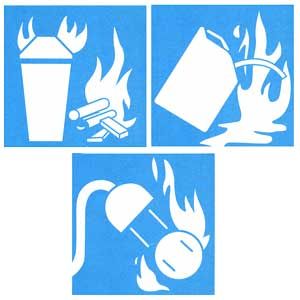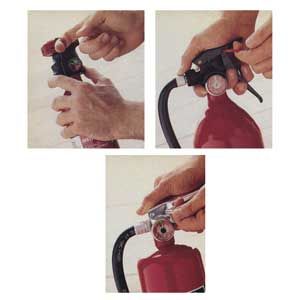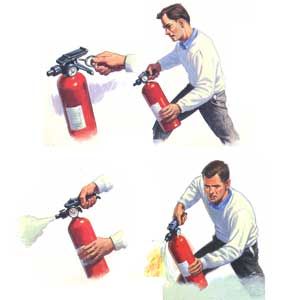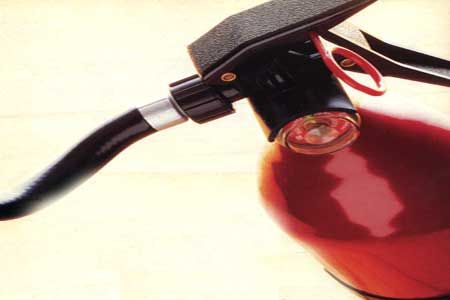Fire extinguishers are crucial for home safety because they’re capable of preventing small fires from becoming catastrophic events. Yet surprisingly, up to 60% of American homes don’t have a fire extinguisher. Our guide covers everything you need to know about getting a fire extinguisher for your home, from selecting the right type to mastering proper use.
Types of Fire Extinguishers
There are several types of fire extinguishers, each designed to combat specific classes of fires. Here’s an overview:
| Fire Extinguisher Class | Types of Fires |
|---|---|
| Class A | Ordinary combustibles such as wood, paper, cloth, and most plastics (the most common residential fires) |
| Class B | Flammable liquids such as cooking oil, gasoline, and kerosene |
| Class C | Electrical fires (note that once the power source is removed, it becomes a Class A or B fire) |
| Multi-Purpose ABC | Designed for Class A, B, and C fires |
| Class D | Fires involving metals, such as magnesium, titanium, or sodium |
| Class K | Kitchen fires involving oils and fats |
Choosing the Best Fire Extinguisher for Your Home
Consider several factors to ensure it meets your specific needs.

Size Considerations
Fire extinguishers come in various sizes and typically weigh between 5 and 7 pounds. While larger extinguishers can tackle bigger fires, they may be too heavy for some. The U.S. Fire Administration recommends choosing the largest fire extinguisher that all adults in the household can handle safely.
Mark Conroy, a member of the National Fire Protection Association (NFPA), suggests extinguishers with a 2-A:10B:C rating. That means they will put out a Class A fire that would otherwise require 2.5 gallons of water; that they should put out a 10-square-foot Class B fire when used by a novice firefighter and a fire up to 25 square feet when used by a pro; and that they work on Class C electrical fires.

Disposable vs. Rechargeable Models
Disposable extinguishers are lighter and less expensive, but can only last about 10–12 years before they lose pressure and must be replaced. Rechargeable models can be refilled after use or if they lose pressure. While more durable, they require annual professional inspections, which can add to long-term costs.
Ease of Use
Make sure the extinguisher is easy to use and comes with clear instructions. This is particularly important for households with seniors or children who might need to use it in an emergency.
Environmental Impact
Some extinguishing agents can be harmful to the environment. Look for options that are eco-friendly without compromising effectiveness.
Cost Factors
Home fire extinguishers typically cost between $30 and $100 t big-box hardware stores. Rechargeable models usually cost more upfront but can be cheaper in the long run if properly maintained.
Certifications and Ratings
The U.S. Fire Administration recommends looking for fire extinguishers that have labels like “UL Listed” or “ULC Listed.” These labels indicate that the extinguisher is certified by recognized testing laboratories and meets specific safety standards.
Proper Placement of Fire Extinguishers in Your Home
Strategic fire extinguisher placement can make all the difference in an emergency. Below is our non-exhaustive list of rooms in your home that should have one.
Kitchen Placement
The Red Cross reports that most residential home fires begin in the kitchen. Place an extinguisher near an exit, about 30 feet from the stove. Never mount it directly above or next to the stove, as you may not be able to reach it safely if a fire starts there.
Garage and Workshop Placement
These areas often contain flammable materials and potential ignition sources. Keep an extinguisher near the exit where it’s accessible but away from areas where a fire is likely to start.
Bedroom Placement
For an extra layer of safety, keep extinguishers near sleeping areas. Place one in the hallway outside bedrooms, making sure it’s easily accessible in the event of a nighttime emergency.
Living Room Placement
The living room often has electrical devices and flammable materials, making it a potential fire hazard. Place a fire extinguisher here to help quickly address any fire that breaks out in this frequently used space.
Outdoor Placement
If you have an outdoor kitchen, barbecue area, or fire pit, don’t forget to place a fire extinguisher nearby. Outdoor fires can spread quickly, and an extinguisher can prevent a small flame from growing out of control.
How To Use a Fire Extinguisher: The P.A.S.S. Technique

Knowing how to use a fire extinguisher correctly is as important as having one. The P.A.S.S. technique is a simple and effective method for operating most fire extinguishers:
- Pull the pin: Remove the safety pin at the top of the extinguisher. This unlocks the operating lever and allows you to discharge the extinguisher.
- Aim low: Point the nozzle or hose at the base of the fire. Aiming at the flames rather than the base is a common mistake that reduces the extinguisher’s effectiveness.
- Squeeze the handle: Firmly squeeze the handle to release the extinguishing agent. If you let go of the handle, the discharge will stop.
- Sweep from side to side: Use a sweeping motion to move the nozzle from side to side at the base of the fire. Continue until the fire appears to be out. Watch the area carefully for reignition.
Once the fire appears to be out, step back and assess the situation. Make sure there are no remaining hot spots or potential sources of reignition. Be prepared to use the extinguisher again if necessary.
Always call emergency services, even if the fire looks extinguished. Local fire professionals can ensure that the fire doesn’t reignite and help you prevent similar fires from happening again.
Maintaining Your Fire Extinguisher
Regularly maintain your fire extinguisher to ensure that it works when you need it most.
Regular Pressure Checks
If possible, check the pressure gauge every week, but at least once every month. The needle should be in the green zone. If it’s not, you may need to recharge or replace your extinguisher.
Annual Professional Inspections
For rechargeable models, have a professional inspect your extinguisher annually. They can check for damage and see that the unit is properly pressurized.
Cleaning and Storage
Keep your fire extinguisher clean and dust-free. Store it in a location that is easily accessible but out of the way of everyday activities. Proper storage prolongs the extinguisher’s life and helps it be ready for use when needed.
When To Replace Your Extinguisher
Replace disposable extinguishers every 10–12 years or sooner if they show signs of damage or low pressure. Rechargeable models can last longer with proper maintenance but should be professionally tested every six years.
Recycling Old Extinguishers
When it’s time to replace an old extinguisher, don’t just throw it in the trash. Many fire departments offer recycling programs or will advise you on proper disposal methods.
Fire Extinguisher Limitations and Safety Precautions
While fire extinguishers are valuable tools, it’s important to understand their limitations and when it’s safer to evacuate. Most residential extinguishers have a range of 6–10 feet, and last only about 10 seconds before they’re depleted. Be aware of these limitations and make fire extinguishers part of your comprehensive safety plan.
When Not To Use a Fire Extinguisher
Don’t attempt to fight a fire if it’s spreading quickly, if you’re unsure how to use the extinguisher, or if the room is filling with smoke. In these cases, evacuate immediately and call the fire department.
The Importance of Smoke Detectors
Fire extinguishers are only one part of a comprehensive fire safety plan. Smoke detectors give early warning, so you’ll have time to evacuate or use an extinguisher if it’s safe to do so. Test your smoke detectors monthly and replace the batteries annually.
The Value of a Sprinkler System
“A heat-activated residential sprinkler system provides the best chance of survival,” says Conroy. The downside is cost, especially when you’re retrofitting an older home. According to Angi, installing a home sprinkler system costs an average of $4,000.
Creating an Evacuation Plan
Develop and practice a home evacuation plan with your family. Identify multiple escape routes from each room and designate a meeting place outside. Remember, your safety is more important than property—when in doubt, get out.
Fire Drills
Practicing regular fire drills can save lives by making sure everyone knows what to do in case of a fire. Conduct drills at different times of day—including at least once at night—and make sure all family members participate. We recommend discussing any potential obstacles so that everyone is prepared.
First Aid Kits
Keep your first aid kit in an easily accessible location. Even small fires can cause minor injuries, such as cuts or burns. Having a first aid kit helps you treat these injuries quickly while waiting for emergency responders.

